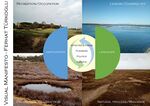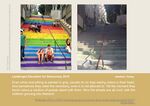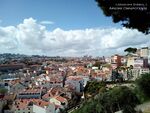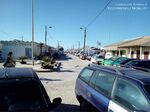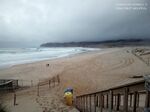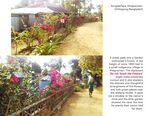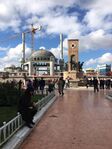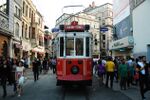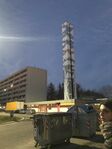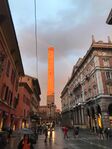LED Online Seminar 2019 - Working Group 8
--> Back to working group overview
Dear working group members. This is your group page and you will be completing the template gradually as we move through the seminar. Good luck and enjoy your collaboration!
Assignment 1 - Reading and Synthesizing Core Terminology
- You can read more details about this assignment here
- Readings are accessible via the resources page
Step 1: Your Landscape Democracy Manifestoes
Step 2: Define your readings
- Please add your readings selection for the terminology exercise before April 24:
A: Landscape and Democracy
1. Burckhardt, Lucius (1979): Why is landscape beautiful? (Göksen)
2. Lynch, Kevin. (1960): The Image of the City (Tahiti)
3. Cosgrove, Denis. (1985): Prospect, Perspective and the Evolution of the Landscape Idea. (Maria)
B: Concepts of Participation
1. The Powerful, the Powerless, and the Experts: Knowledge Struggles in an Information Age. (2019). (Ferhat)
2. Day, Christopher & Parnell, Rosie (2002): Consensus Design (Göksen)
3. Freire, Paulo (2000): Pedagogy of the Oppressed (Maria)
C: Community and Identity
1. Welk Von Mossner, Alexa (2014): Cinematic Landscapes (Göksen)
2. Hester, Randolph (2006): Design for Ecological Democracy - Sacredness (Tahiti)
D: Designing
1. Hester, Randolph (2006): Design for Ecological Democracy - Everyday Future (Tahiti)
2. Hester, Randolph (1995): Life, Liberty and the Pursuit if Sustainable Happiness (Ferhat)
E: Communicating a Vision
1. Potteiger, Matthew, and Jamie Purinton. 1998. Landscape narratives: design practices for telling stories. (Maria)
2. Brownson, Omar, and Marsh, Emily. Urban Coast 4/1. (2013). Los Angeles River 3.0: Changing the course of Los Angeles. (Ferhat)
Steps 3 and 4: Concepts Selection and definition
- Each group member selects three relevant concepts derived from his/her readings and synthesize them/publish them on the wiki by May 15, 2019
- Group members reflect within their groups and define their chosen concepts into a shared definition to be posted on the wiki by June 12, 2019.
- Other group members will be able to comment on the definitions until June 30, 2019
- Each group will also report on their process to come to a set of shared definitions of key landscape democracy concepts on the wiki documentation until July 12, 2019
Concepts and definitions
Author 1: Maria Augusta Kroetz
- The Landscape Idea:
The idea of landscape defined by Cosgrove can be translated, into few words, as the relation between society and space. The term "landscape" acquires several meanings depending on its conception within a given language and depending on the historical period, however, Cosgrove indicates some important constants for the understanding of the concept, being: a) the understanding of landscape as a scientific visual concept - the author emphasizes the importance of the exact and scientific definition of the term landscape so that it can be used as an objective vocabulary without falling into metaphysical reveries. b) the relationship between society and space is translated into the landscape - Cosgrove identifies several historical moments in which the concepts and forms of landscape have changed depending, for example, on the type of government that was in power in that particular place. c) the geographic and cultural specificity of the term landscape - the author, in a very broad but objective definition, manages to rescue the innumerable variants of the term landscape that undergo cultural and geographical differences.
- The pedagogy of the Oppressed
The pedagogy of the oppressed is aimed at the humanization of us all. Paulo Freire develops a methodology of mass liberation based on the awareness of the oppressed in the current society. Freire begins with an analysis of current society and divides it into two groups: the oppressed and the oppressors. Some key concepts give substance to his methodology, being: a) class consciousness - the oppressed must understand their place of oppressed in society and recognize the oppressor. b) the pedagogy of the oppressed must be thought and acted upon by the oppressed - a pedagogy that comes from "above" will never be a means of liberation for the oppressed. c) the need to change the status quo - the oppressed can not seek their liberation in order to become an oppressor, the means of this type of work must be equality and "re-humanization" of all.
- Story Telling
Storytelling theory can be understood, generally, as a way of approaching the public. In urban planning it is an instrument that can be used to increase the sense of belonging of the people to that urban reality. It can be used as an instrument on the part of "urban planning technicians" as a kind of fable for a more efficient approach to the group in question and also as an instrument that the public can use to reaffirm the urban reality in which they are inserted.
Author 2: Ferhat Türkoglu
- The Powerful, The Powerless and the Experts
It is a clash between two types of education. On the on hand the knowledge of expertise which is considered by law as ‘official’ and on the other hand knowledge of experience. Through an extreme example it is shown how relatively powerless individual figures and groups are when facing bureaucracy of states. But it is certainly not just a national issue or a question of wealth of a country. It is a question of an era in which mankind is living. Based on experts like Daniel Bell the preindustrial society ‘evolved’ into an industrial and then into a post-industrial society. That means the coordination of men and machines moved into a knowledge-based society, in which the socio-culture and the socio-economy is managed politically. In case of ‘economic democracy’ all three eras represent a party of interests. The landscape itself depends on participatory knowledge of the future. To achieve this goal democracy must reform the dominating knowledge of today.
- Life, Liberty and the Pursuit of Sustainable Happiness
The well-being, security and personal identity of a city’s population is based on environmental costs. In this era mankind is consuming non-renewable resources in a rate that affects the next generation extremely. These long-term consequences increase simultaneously with technologies and daily habits. If we want to stop this cycle of non-sustainability, we must change both the environment and the people who live alongside with it. Information is the key for education and public awareness. The result is a transformation of an individual life based on the current situation of a city. Enabling, resilience and impelling are the three guiding forms which structure an evolving sustainable city.
- Los Angeles River 3.0
The metropolitan city Los Angeles is mainly known for its Californian lifestyle, warm weather and concrete landscape based on a grid infrastructure. The river formed and changed the face of the city through centuries. The potential of its surrounding open space areas is immense which is now enjoyed by different activities by the citizens. The concept is simple and effective. If you change the landscape, mankind adapts. This is also a part of landscape democracy. Not only planners, citizens and politics affect landscape, the landscape affects its surroundings, too. In case of the ‘Greenway’-concept of LA River, the idea itself gave people well-being and socio-culture. A place in which they can identify themselves. Major investments are going to be achieved which help the restoration of the ecosystem as well. Connectivity is the result of this landscape-human combination.
Author 3: Göksen Ezgi Boz
- Why landscape is beautiful?
Landscape expresses different meanings for many people. It does not occur as an appearance such as colors, but also social sides support this concept/idea. An understanding of a landscape is influenced by our life experiences. Therefore, the perception of a beautiful or soothing is perspective oriented and subjective.
- Consensus Design
In this article, the author highlights better ways to make ethical decisions. He compares the democratic voting system vs. consensual approach. In democracies, the system usually is influenced by the demands of the majority, while the minority’s requests are disregarded. The author defines compromising as a crucial step to reach collective decisions and consensus. According to him, we can get a more comprehensive solution with equitable, productive and conscious actions. Reaching an agreement, deciding what is best for our civilization should be on the top of the list for everyone. Limited thinking and old ways should change, and our communities should be able to expand to a more flexible structure. With empathy and ...., we can transform our collective consciousness.
- Cinematic Landscape
Image of the landscape creates a sense of belonging and allows us to establish a relationship with the place. It reflects the identity of the space very beautifully and performs an instrumental role in the transmission of the story. The author gives more details of the cinematic landscapes in the movie called "Beasts of the Southern Wild." The film reveals the story of today`s environmental realities from the perspective of a six years old girl. Even though the story is based on fiction, the movie excellently focuses on valid issues such as environment, racial, and gender.
Author 4: Rahnuma Ahmad Tahiti
- Image of the city (Mapping the Terrain)
Designing a city goes beyond architecture, art or any traditional working process. If the observer's eyes can find coherency, balance, and clarity while taking a walk in the city that will probably to an extent prove the success of the city's design. My takeaway from this book would be the emotional process the writer goes through to find the image of a city. It's the perception of the users which is at the end important for him, as these are the people who take hundreds of walks through the city's streets to and front for years. His ways of finding clarity, legibility, simplicity, continuity, etc. and how the joints, nodes, paths, and landmarks of the cities should be analyzed is something that every enthusiast of urban design should study. If nothing, at least to know how to observe informally a city's nooks and streets from a closer angle.
- .......
- Design for Ecological Democracy - Sacredness (Community and Identity)
-The places people are attached to, have special significance to them and carry meanings. These values, attachments, connections are built over a period of time.
-The buildings and landscapes that belong to a particular community reinforce the everyday pattern of that community’s life. These places shape their sense of community values and use pattern. Therefore the loss of these essential memorable places would reorder or destroy their everyday social process, which is vital for the community’s collectiveness.
-The collective sense of sacredness in a community can inspire people to achieve preservation of a particular landscape and its virtues, which might not have been possible in other scenarios.
-When collective wellbeing of people is the prior concern, the design of an area would benefit the whole urban neighborhood. Community goal would be prioritized rather than commercial gain.
-Different landscape elements like mountains, orchards or a shallow creek might have certain associated feelings with it like a childhood memory, or a strong emotion of faith, nurture or care. These elements also carry different values according to different cultures. This language of the landscape can be used to transcend/incorporate the emotion of the communities in the design of the city.
-Since sacredness is associated with design building on goodwill and goodness, prioritizing heart but also unifying the scientific ground, and everything that is organic, nonviolent or beautiful; a gestalt can be achieved which is soul touching and inspiring for the inhabitants of a city.
Step 5: Reflection
Step 6: Revised manifestoes
- please look again at your initial manifestoes and update them with any new aspects/prespectives you have taken up during this seminar
Assignment 2 - Your Landscape Symbols
- You can read more details about this assignment here
Landscape Symbols Author 1: Ferhat Türkoglu
Landscape Symbols Author 2: Rahnuma Ahmad Tahiti
Lake Side Square, Zurich, Switzerland. The activity of people in the urban open space with music, food & sightseeing. To me the liberty to enjoy this urban open space with the lake in the front and this scenic beauty, this experience in itself means democracy, and landscape democracy, so to say. 47.3663535,8.5445599
Do not touch the flowers. Location: Khagrachari, Chittagong, Bangladesh. A sneak peek into a garden enthusiast's house, in the height of some 1800 feet in a small indigenous village in Khagrachari. The signboard 'do not touch flowers' might make passersby curious and it also explains the thoughtful arrangements of the flowers and lush green plants near the walking routes. It gave me a window to the owner's mind.23.4115976,92.2712831
Martyr Monument. Location: University Road, Dhaka, Bangladesh. Built in the commemoration of the martyrs killed during the language movement of 21st Feb 1952. The monument symbolizes the importance of Bengali language for the public, as language is one of the basic rights of people. The place stands as a witness of the history as on this exact place the movement took place. It is at the same time a social, cultural and political symbol. 23.7266351,90.3953682
Landscape Symbols Göksen Ezgi Boz: ...
Taksim square represents history. It is a famous place symbolizing the birth of the modern Turkish Republic. Also it’s an important landmark and serves to citizens and tourists as city compass. The city’s heartbeats can be heard from there because it connects people who comes from different taste of politic, religion and philosophies. 41.036876, 28.985157
The Gezi Park is located next to the historical Taksim Square in Beyoglu which is one of the busiest intersections in Istanbul. The park is small but has enough green space to sit down and relax.It provides a comfortable setting for people who need to be away from the chaos of the outside world. It is like a secret garden where people can quietly revitalize. After the protests in 2013, Gezi Park became a more powerful symbol for inhabitants. 41.038871, 28.987050
Istiklal is a historical, commercial and vivid open space in Istanbul. It welcomes thousands of people on their way in the morning and night as well as many tourists dwelling the city. It’s represent social communication and openness. The heart of the city beats here people from all walks of life exist peacefully. 41.035452, 28.982104
Landscape Symbols Author 4: Maria Augusta Kroetz
This is the tower of an aqueduct in a suburban area of the city of Bologna, Corticella. In this district this tower, after a process of restructuring the neighborhood to increase the feeling of belonging to it, has acquired a role of territorial demarcation and meeting point of the citizens of Corticella.
Labas is a Political collective of Bologna that has occupied an old barrack in the city center that wasn't being used. Now this collective organizes political and cultural manifestations every week and promotes a space of discussions and cultural appropriation. This picture was taken during a movie's premiere that has takes place on the old barrack occupied by Labas.
Assignment 3 - Role Play on Landscape Democracy "movers and shakers"
- You can read more details about this assignment here
Assignment 4 - Your Landscape Democracy Challenge
- You can read more details about this assignment here
- Each group member will specify a landscape democracy challenge in his/her environment
Landscape Democracy Challenge 1
- Give a title to your challenge
- Yourname challenge 1.jpg
caption: why did you select this case?
- Yourname challenge 2.jpg
caption: what is the issue/conflict (1)
- Yourname challenge 3.jpg
caption: what is the issue/conflict (2)
- Yourname challenge 4.jpg
caption: who are the actors?
Your references:
- ...
- ...
Landscape Democracy Challenge 2
- Give a title to your challenge
- Yourname challenge 1.jpg
caption: why did you select this case?
- Yourname challenge 2.jpg
caption: what is the issue/conflict (1)
- Yourname challenge 3.jpg
caption: what is the issue/conflict (2)
- Yourname challenge 4.jpg
caption: who are the actors?
Your references:
- ...
- ...
Landscape Democracy Challenge 3
- Give a title to your challenge
- Yourname challenge 1.jpg
caption: why did you select this case?
- Yourname challenge 2.jpg
caption: what is the issue/conflict (1)
- Yourname challenge 3.jpg
caption: what is the issue/conflict (2)
- Yourname challenge 4.jpg
caption: who are the actors?
Your references:
- ...
- ...
Landscape Democracy Challenge 4
- Give a title to your challenge
- Yourname challenge 1.jpg
caption: why did you select this case?
- Yourname challenge 2.jpg
caption: what is the issue/conflict (1)
- Yourname challenge 3.jpg
caption: what is the issue/conflict (2)
- Yourname challenge 4.jpg
caption: who are the actors?
Your references:
- ...
- ...
Your Democratic Change Process
- Add Title
- Your Democratic Change Process Slide1.jpg
caption: ...
- Your Democratic Change Process Slide2.jpg
caption: ...
- Your Democratic Change Process Slide3.jpg
caption: ...
- Your Democratic Change Process Slide4.jpg
caption: ...
Reflection
- ....
- ....
- ....
Conclusion:
- ....
- ....
- ....
Your references
- ...
- ...
- ...

